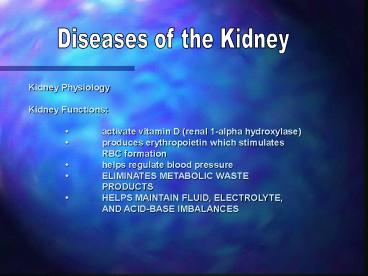Diseases of the Kidney - PowerPoint PPT Presentation
1 / 16
Title:
Diseases of the Kidney
Description:
activate vitamin D (renal 1-alpha hydroxylase) produces erythropoietin which stimulates ... Biochemistry (albumin, prealbumin, cholesterol, K, creatinine, BUN) ... – PowerPoint PPT presentation
Number of Views:61
Avg rating:3.0/5.0
Title: Diseases of the Kidney
1
Diseases of the Kidney
Kidney Physiology Kidney Functions activate
vitamin D (renal 1-alpha hydroxylase) produces
erythropoietin which stimulates RBC
formation helps regulate blood
pressure ELIMINATES METABOLIC
WASTE PRODUCTS HELPS MAINTAIN FLUID,
ELECTROLYTE, AND ACID-BASE IMBALANCES
2
Kidney Diseases of Note
- Glomerulonephritis (acute or chronic)
- Nephrotic Syndrome
- Acute Renal Failure
- Chronic Renal Failure
- Dialysis
- Urinary Calculi
3
A Few Definitions
Renal Filtrate fluid from the blood filtered by
the kidneys that forms urine. GFR Glomerula
r Filtration Rate the rate at which the kidney
forms renal filtrate. Normal 90-120
ml/min Renin enzyme secreted by kidney in
response to low blood flow results in
adrenal signal (aldosterone) to cause kidney
to retain Na and water.
4
A Few More Definitions
Nephrotic Syndrome a cluster of symptoms
proteinuria low serum albumin
edema hyperlipidemia Sometimes an early
sign of renal failure. Caused by infections,
certain drugs, toxins, DM, renal
blood clots.
5
Consequences of Nephrotic Syndrome
Proteinuria
Albumin Immunoglobulins
(immunity) Transferrin (anemia) Vita
min D-BP (rickets)
Low serum proteins fluid
shift into interstitial spaces Low Blood
Volume Edema Kidneys Respond
Retain Na and fluids!!!!
6
Diet in Nephrotic Syndrome
Energy 35 kcal/ kg Protein 0.8-1.0 g /
kg Fat lt 30 of kcals low in saturated fatty
acids. Sodium During edematous phase 250
mg/day As edema resolves to 1500 mg/
day
7
Prerenal Postrenal
Intrarenal LOW RENAL
OBSTRUCTION KIDNEY DAMAGE BLOOD FLOW
IN URINARY TRACT
Acute Renal Failure
SUDDEN PRECIPITOUS DROP IN GFR, URINE OUTPUT
8
DEFINITIONS KIDNEY FAILURE
UREMIA/ AZOTEMIA Build-up of urea nitrogen in
the blood (BUN). Normal 10-20
mg/dl Uremia 50-150 mg/dl ESRD 150-250
mg/dl ARF Phases 1. Oliguric reduced urine
volume 2. Diuretic large fluid/electrolyte
losses 3. Recovery NL renal function
9
Uremic Syndrome
Build-up of toxic waste products in the blood
(e.g., urea, potassium) Symptoms Weakness,
Fatigue Dull mental state Anorexia,
N/V/D, altered taste, subdermal hemorraging
10
Causes of Chronic Renal Failure
- Diabetic or HIV-Related Nephropathy
- Recurrent Glomerulonephritis or Pyelonephritis
- Acute Non-Responsive Kidney Failure
- Nephrosclerosis
- Cardiac Failure
- Extensive Atherosclerosis
- Malignant Hypertension
11
Early Accurate Assessment
- Anthropometrics (lt 20 BMI or lt 80 body weight
- Biochemistry (albumin, prealbumin, cholesterol,
K, creatinine, BUN) - Clinical Assessment (edema, GIT)
- Dietary Intake( protein, calories, K, PO4)
12
Without Adequate Protein/ Kcals Hypermetabolic
state Break down visceral protein
stores Hyperkalemia worsens. Kcal
needs 30-50 kcal/kg (depending on level of
catabolism) Oliguric phase Diuretics, restrict
fluids, Na and K. Diuretic phase Fluids
and K supplements
13
Measuring fluid needs Measure urinary output,
then add 500 ml for insensible losses.
14
Protein Needs in ARF
Non-Dialyzed Pts Dialyzed Pts 0.6 to 1.0 g/
kg 1.1-2.5 g/ kg
Feeding in Enteral and Parenterally-Fed
Patients Less Protein, Electrolytes Lower amino
acid High Kcal Density Higher Dextrose
Insulin may be used to
control hyperglycemia
15
- Medications
- Hyperkalemia - Exchange resins (po or enema)
- e.g.polystyrene sulfonate to increase fecal
- potassium losses by exchanging sodium.
- Hyperphosphatemia - Phospate binders e.g.
- Phosphlo Tums (Ca based) Magnabid (Mg
- based) Amphogel (Al based) Renagel (polymer)
- Anemia - Iron
- Edema - Diuretics
16
Dialysis
Removal of blood waste products through
a semi-permeable membrane via diffusion/osmosis.
Hemodialysis Large blood vessel tapped,blood
routed through dialysis machine, excess
fluid/ electrolytes are removed. Dialysed
blood returned to body.
Peritoneal Dialysis Dialysis is accomplished
using peritoneal cavity as the semi-permeable
membrane.































